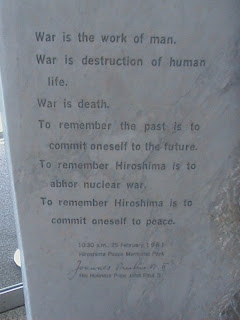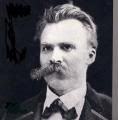In the summer of 2009, I had the opportunity to go to Japan for two weeks on a student exchange with a few other friends from my high school. While there, we spent half a day in Hiroshima where we visited the rather "depressing" (to quote my journal for that day) Atomic Bomb Museum. Here are some pictures and videos from my experience. Forgive the shaky camera, just pause it if you need to get a better look. I encourage anyone who gets the chance to visit this amazing museum.
This pillar is at the entrance to the museum.
This video shows a before and after model of part of the city where the bomb hit.
The T-shaped bridge was the target of the bomb.
This is where the bomb exploded.
"I fought with myself for 30 minutes before I could take the first picture. After taking the first, I grew strangely calm and wanted to get closer. I took about ten steps forward and tried to snap another, but the scenes I saw were so gruesome my viewfinder clouded with tears."
- Yoshito Matsushige
This was one of the most staggering pictures for me. It's the mark left by a man who was sitting on the stair when the bomb went off.
One of the only buildings they preserved.
I had one more video I wanted to show but I guess it's too long to upload from my computer. To summarize, it showed the city a year after the bombing. The population had recovered to about 180,000 people, a black market arose, a former military installation became a new housing area, open-air classrooms were organized, the Aioi bridge was reconstructed, and "the city made progress under a goal of becoming a City of Peace."
Nobody began the Atomic Age more literally than these people. The greatest thing I got our of this experience wasn't the sickening feeling of the effects of atomic warfare, but rather the lack of hatred from the Japanese people. There were no signs of grudges they still might be holding. They remember the past not to avenge it, but to learn from it.








